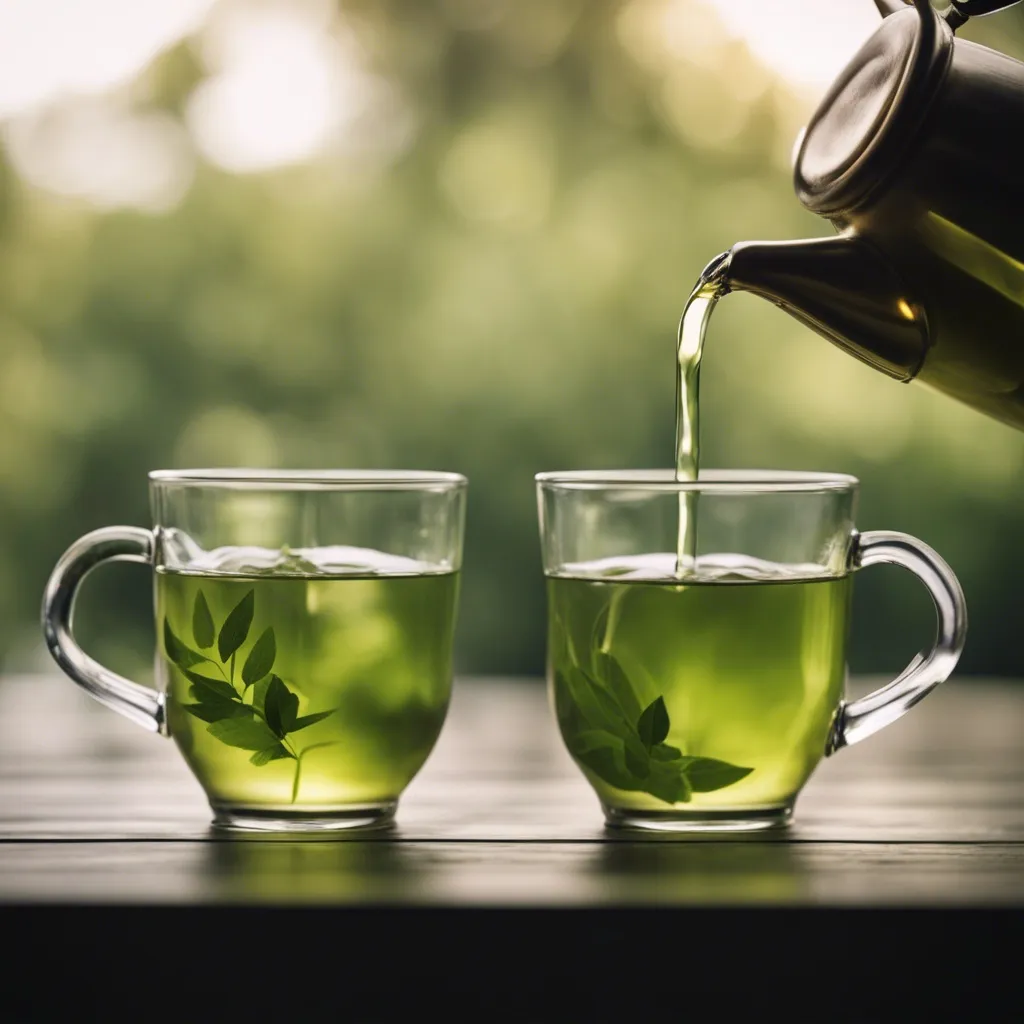What is green tea?
Introduction to Green Tea
Green tea is much more than a drink. It’s a tiny leaf with a big story. These leaves come from the Camellia sinensis plant and are lightly processed, making them different from black or oolong teas. When you brew green tea, you unlock a world of flavours - grassy, earthy, sometimes floral or sweet, and it’s not just about taste. Often, green tea is consumed for health reasons as it can be good for your heart and might even help with weight loss, thanks to its antioxidants. Simple to make yet rich in history and benefits, green tea is extraordinary.

The Historical Roots of Green Tea
Rewind to 2737 BC in ancient China, when the first chapter of the story of green tea was written. Picture Emperor Shen Nong, a revered figure in Chinese mythology, as he made a fortuitous discovery. While boiling water beneath a tree, some leaves gently floated down into his pot. This event led to an accidental infusion that resulted in an aromatic beverage that we know today as green tea. Emperor Shen Nong had a long history of expertise in agriculture and medicine so he was quick to spot that green tea had numerous other potential benefits, and this marked the beginning of green tea’s future significance across the world.
Lu Yu didn’t just write about tea, he turned it into a symbol of prosperity; his work transformed drinking tea into a classy and thoughtful thing to do; drinking tea had become an art form. As a result, tea gardens became wildly popular places where slowly sipping your tea became a classy and thoughtful thing to do. Thanks to the Tang Dynasty’s love for tea, we see green tea in a new light today; it’s more than just a beverage; it’s a way to express ourselves and find some peace, something we still appreciate every time we enjoy a cup.
Tang Dynasty (618-907 AD)
During the Tang Dynasty, from 618 to 907 AD, green tea experienced a renaissance. This period is often hailed as the golden age of Chinese culture, and it was during these centuries that green tea firmly established its place in Chinese society. Lu Yu, an orphan turned scholar, emerged as a pivotal figure in tea history. His seminal work, ‘The Classic of Tea’, written around 760 AD, is a testament to the era’s deep appreciation for the beverage. This book meticulously detailed everything from tea cultivation to the art of tea drinking, offering a glimpse into the sophisticated tea culture of the time.
Lu Yu didn’t just write about tea, he turned it into a symbol of prosperity; his work transformed drinking tea into a classy and thoughtful thing to do; drinking tea had become an art form. As a result, tea gardens became wildly popular places where slowly sipping your tea became a classy and thoughtful thing to do. Thanks to the Tang Dynasty’s love for tea, we see green tea in a whole new light today; it’s more than just a beverage; it’s a way to express ourselves and find some peace, something we still appreciate every time we enjoy a cup.
Japan’s Tea Culture (9th Century Onward)
As we crossed over to Japan in the 9th century, green tea began to embrace a new identity. Brought over by Buddhist monks from China, the seeds of green tea found fertile ground in Japanese culture. Initially, tea in Japan was a luxury, savoured primarily by monks and the elite. The monks used it as a tool for meditation and for helping them stay alert during long hours of contemplation due to the caffeine. By the 12th century, however, drinking tea had spread across all layers of society and evolved into a tea ceremony that we know today.
The pivotal moment of the Japanese tea ceremony, known as ‘Chanoyu’ or ‘Chado’, blossomed in the 15th and 16th centuries. The ceremony, deeply rooted in Zen Buddhism, turned tea preparation and consumption into a spiritual journey, emphasizing simplicity, harmony, and inner peace. A tea ceremony isn’t just about enjoying a cup of tea; it’s a holistic experience that encompasses the setting, the utensils, the company, and the mindset. A Japanese tea ceremony invites us to slow down, appreciate the moment, and connect with traditions.
Varieties of Green Tea
The various types of green tea all have their own unique flavour and customs, this is shaped by how it is cultivated and prepared. Whether it’s the steaming process of Sencha, the shade-grown leaves of Matcha, or the pan-firing technique used in making Dragon Well, each type of green tea brings its own character and history to the cup.
Sencha: The Quintessential Japanese Green Tea
Sencha, often seen as the heart of Japanese green tea culture, embodies a perfect harmony of flavour and tradition. Grown under full sun, its leaves are steamed to preserve their vibrant green colour and fresh taste. The resulting tea from this process gives you a refreshing and invigorating feeling with a well-balanced sweet and bitter flavour. Sencha is typically used as an everyday item, but don’t let that put you off; its depth of flavour reveals subtle layers with each sip.
In contrast to other green teas, Sencha’s preparation is quite straightforward. Simply steeping the leaves in hot water brings out their best qualities. Sencha is a perfect starting point if you’re new to Japanese teas, as it’s simple to prepare, but you will still have a very rewarding and spiritual experience.
Matcha: The Vibrant Green Powder
The vibrant green powder Matcha has become recognized worldwide due to its unique preparation and its rich cultural significance in Japan. Made from finely ground, shade-grown tea leaves, Matcha presents a robust, creamy texture unlike any other tea. Its preparation is considered an art form in itself, commonly associated with Japanese tea ceremonies where every detail matters.
For us Matcha lovers, the experience of whisking the powder into a frothy, bright-green liquid is almost meditative. The taste is equally profound, a mix of sweet, umami, and slight bitterness that lingers pleasantly on the palate.
Gunpowder Tea: The Chinese Specialty
Gunpowder tea, a classic from China, gets its name from its unique appearance. The leaves are rolled into small, tight pellets resembling gunpowder grains. When steeped, these pellets unfurl, releasing a bold and slightly smoky flavour. Commonly known for its refreshing qualities and a hint of astringency, it is a favourite among green tea enthusiasts.
The process of rolling Gunpowder tea isn’t simply for aesthetics; it helps preserve the tea’s freshness and flavour. When we brew it, we witness a little spectacle as the leaves slowly expand, reminding us of the careful craftsmanship that goes into each pellet.
Longjing (Dragon Well): A Chinese Treasure
Longjing tea is the jewel in the crown of Chinese green tea, nestled in the landscapes of Zhejiang province; this tea is a legend in its own right. Picture those unique, flat leaves - they’re not just leaves; they’re tiny masterpieces, bursting with a sweet, nutty melody that dances on your taste buds. The leaves are pan-fried with such precision it’s like they’re whispering ancient secrets, giving Longjing its iconic smooth, toasty vibe that’s been winning hearts for ages.
Now, brewing a cup of Longjing isn’t just your regular tea-making ritual. Oh no, it’s like stepping into a time machine and sipping on Chinese tea heritage itself. Imagine its calming scent wrapping around you and that gentle taste lingering on your tongue. It’s like a tranquil retreat in a cup, perfect for those moments when you just need to pause and breathe.
Gyokuro: The Shade-Grown Delicacy
Sipping on Gyokuro is like treating yourself to a bit of luxury from Japan. Imagine a flavour that’s rich and full of umami goodness, a perfect blend of sweet and smooth. Gyokuro gets its unique taste from a special trick - it’s grown in the shade for weeks before it’s picked. Growing in the shade increases the tea leaves’ chlorophyll and amino acid levels, giving them their striking deep green hue colour and the resulting bold and satisfying taste.
Brewing Gyokuro is an art form, and it’s all about taking your time and doing it with care. You need cold water and patience to let it steep a bit longer. But get it right, and oh boy, you’re in for a treat! Gyokuro tea captivates your tastebuds with a rich umami taste, subtle sweetness, minimal bitterness, fresh vegetal notes, a smooth and full-bodied texture, and an inviting, grassy aroma.
Hojicha: Roasted Green Tea Aroma
Imagine cozying up with a cup of Hojicha, a gem among green teas. Unlike the typical steaming, Hojicha leaves are gently roasted in a porcelain pot over glowing charcoal. Through this process, the leaves turn into a reddish-brown colour, and as a result, the caffeine levels are reduced; this makes Hojicha the go-to for a gentler, calming sip.
The distinct taste of Hojicha is a wonderful option for both tea enthusiasts and beginners. Its flavour profile is grassy and mellow, making it incredibly smooth and soothing. The aftertaste is pleasantly light, with just a hint of nuttiness, rounding off each relaxing sip.
Conclusion
Green tea is steeped in a blend of rich history and varied traditions. Picture its journey from an accidental discovery in ancient China to its celebrated role in Japanese tea ceremonies.
Each type of green tea, like the lively Sencha, the zen Matcha, the unique Gunpowder, the revered Longjing, or the relaxing Hojicha, has its own tale that is accessible with every sip, they have become a symbol of both Chinese and Japanese traditions and culture.
Enjoying a cup of green tea is an experience, a connection to history, and a pause in our busy lives. Next time you have a cup, remember it’s not just tea - it’s a centuries-old tradition that still adds a bit of calm to our days.
About the author
Sophia Gouse, a passionate advocate for the art and culture of green tea, is the creative force behind this blog. Her writing offers a rich tapestry of content, from detailed reviews of green tea varieties, guides on brewing techniques, health benefits of teas and explorations of tea culture around the world.
